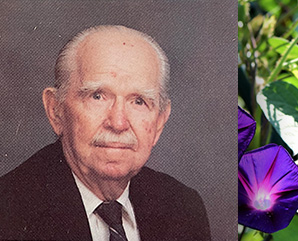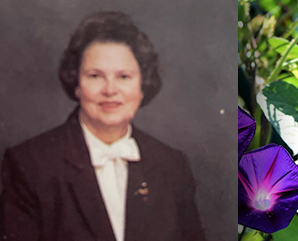
Claude Russell | The Morganton Years
In a nursing home in Valdese, NC, I met Claude Russell – white hair, white moustache and underneath the moustache a happy disposition. I introduced myself to him, and he snapped my picture with his Polaroid camera. We watched me develop. After I sat down, Claude told me he was a furniture salesman. He opened a scrapbook and pulled out an article entitled “The House That Furniture Built.” The article detailed “one of the most beautiful homes in Morganton” and how Claude’s ability to sell furniture had made it all happen.
The room that I sat in with Claude had only one cabinet that seemed to be of any value, while the rest of the room was done in a nursing home motif. I couldn’t help comparing the magnificence of “what was” to the starkness of “what is.” I’m not sure I got the truth of the situation from Claude, but the way he spun the tale Parkinson’s Disease took his health and his wife. His wife then took the house and sold it.
Some may know whether that happened or not. I know that the next thing on Claude’s agenda was to show me his scrapbooks, which were filled with Polaroid pictures of everyone who had visited him over the past five years. “These people are my family,” he said.
I visited Claude once a month. Out came the scrapbooks, and the longer I was a pastor there the more I recognized that the people in the scrapbook all came from the church. “These people are my family,” he would say. “They’re mine, too,” I would answer back.
When I became a pastor, I was surprised to find myself asking a question that I thought I would have answered many years earlier: “Why do people come to church?” Now I join those people who say, “I don’t know what I’d do without my church!”

Miriam Bowditch | The Morganton Years
Miriam was in charge of the flowers in the sanctuary. There was one arrangement that was placed on a ledge right below the cross. On a few occasions I was in the sanctuary with Miriam. She would have me help her to place the large flower arrangement in the center of the ledge, between the six candles of creation, and directly under the cross. Miriam would then stand halfway down the aisle, close one eye, and give me a thumb that indicated that the flowers needed to be moved in the direction of what said thumb indicated. After I had moved the flowers, I would most often receive another thumb that indicated that the flowers must now be moved back a bit in the other direction. This exercise could go on for some time…
Miriam has now long since passed. If present church trends are any indication, she has been replaced by a team of seventeen people, one of whom will spend Saturday mornings calling others to try to find a sub; either that or she’s been replaced by four rotating silk flower arrangements, a decision that saves both time and money.
God bless Miriam and those souls who know where the center of life is located and quietly give their gifts to the Lord. I need to take some direction from them, some direction that could go on for some time…